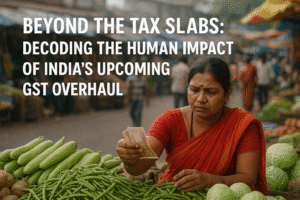Beyond the Tax Slabs: Decoding the Human Impact of India’s Upcoming GST Overhaul
In a significant move aimed at providing widespread economic relief, India is overhauling its GST structure to simplify it into primarily two tax slabs. The proposed reform, announced by FM Sitharaman, seeks to reduce rates on everyday essentials to 5% and establish an 18% standard rate for most goods, thereby lowering costs for the middle class. Farmers stand to benefit from reduced prices on agricultural inputs and logistics, while small businesses will gain from a dramatically simplified compliance process.
This streamlining is designed to ease the administrative burden on MSMEs, allowing them to focus on growth. The changes, championed by PM Modi, target a swift implementation by Diwali. The success of this next-generation reform hinges on building consensus with states, balancing revenue needs with the promise of putting more money back into the hands of consumers and producers.

Beyond the Tax Slabs: Decoding the Human Impact of India’s Upcoming GST Overhaul
When Finance Minister Nirmala Sitharaman stood before the Group of Ministers this week, her message was clear: India’s flagship Goods and Services Tax (GST) is poised for its most significant transformation since its inception. The proposed shift, aiming to simplify the complex multi-rate structure into primarily two slabs, is being billed not just as an economic reform, but as a direct measure to ease the financial burden on the core of the Indian economy—the middle class, farmers, and small businesses.
But what does this technical “rate rationalisation” truly mean for the average Indian household and entrepreneur? Let’s look beyond the headlines.
From Four Pillars to Two: The New Proposed Structure
The current GST regime is a labyrinth of four primary tax rates (5%, 12%, 18%, and 28%), plus a compensatory cess on top of the highest slab for luxury and sin goods. This complexity has often led to confusion, classification disputes, and compliance headaches.
The new vision is strikingly simple:
- A 5% slab for essential goods and mass-consumption items.
- An 18% slab that becomes the new standard rate, covering a vast majority of goods and services.
- A top-tier rate (reportedly ~40%) reserved for a mere 5-7 ultra-luxury or demerit goods.
This simplification is the first step towards reducing compliance costs and bureaucratic friction, a silent tax that small businesses pay every day.
More Money in the Pocket: The “Ease of Living” Promise
The government’s rhetoric of “ease of living” translates into tangible relief for the common citizen. The key mechanism here is the potential shift of many everyday items from the current 12% and 18% slabs down to 5%.
Imagine the impact on a monthly household budget:
- Food items like packaged cereals, spices, and certain edible oils could see a price drop.
- Apparel below a certain price point, a significant monthly expense for many families, might become cheaper if moved to a lower slab.
- Consumer durables and everyday appliances like fans, lamps, or kitchenware could become more affordable.
For a middle-class family grappling with inflation, even a modest reduction in the cost of a dozen daily-use items can collectively make a meaningful difference at the end of the month.
Empowering the Annadata: Direct and Indirect Relief for Farmers
While agricultural produce (like raw vegetables and grains) is largely exempt from GST, the farming community is deeply intertwined with the taxed economy. The proposed reforms offer them dual benefits:
- Reduced Input Costs: Farmers pay GST on critical inputs like fertilizers, pesticides, agricultural machinery (tractors, harvesters), and even tractor parts. A rationalisation that lowers the duty on these items directly reduces the cost of cultivation, boosting the farmer’s net income.
- Logistics and Storage: Services like transportation and warehousing, crucial for getting produce to the market, are under GST. A simpler, potentially lower rate on these services makes the entire supply chain more efficient and less costly.
This isn’t just about consumption; it’s about reducing the cost of production and commerce for India’s annadatas.
The Small Business Boost: Easing the Compliance Burden
For MSMEs (Micro, Small, and Medium Enterprises), the GST overhaul is a potential game-changer. The complexity of navigating multiple tax rates and filing returns accordingly consumes immense time and resources—a luxury small businesses don’t have.
A two-rate system is inherently simpler. It means:
- Fewer classification errors: Less time spent debating whether a product falls under 12% or 18%.
- Streamlined accounting: Simplified invoicing and bookkeeping.
- Reduced litigation: A clearer system minimises disputes with tax authorities.
This administrative ease allows small business owners to redirect their focus from navigating red tape to what they do best: growing their business and creating jobs.
The Road Ahead: Consensus and Caution
The government’s target for a Diwali rollout is ambitious, underscoring its intent to deliver a festive-season gift to the public. However, the path is paved with the spirit of “cooperative federalism.” The Centre must build a broad consensus among states, some of which are wary of potential revenue shortfalls during the transition.
Furthermore, the revenue neutrality of the new structure is crucial. Lowering rates on essentials must be balanced by the expanded base of the 18% standard rate and the high tax on luxury items to ensure the states’ fiscal health is not compromised.
In conclusion, this GST rejig is more than a tax reform; it’s a recalibration aimed at putting money back into the hands of consumers and reducing the operational friction for small producers. By prioritising simplicity and sensitivity, the next-generation GST has the potential to truly become a “good and simple tax” for the people it serves. The Diwali deadline promises not just brighter lights, but a lighter financial load for millions.
You must be logged in to post a comment.